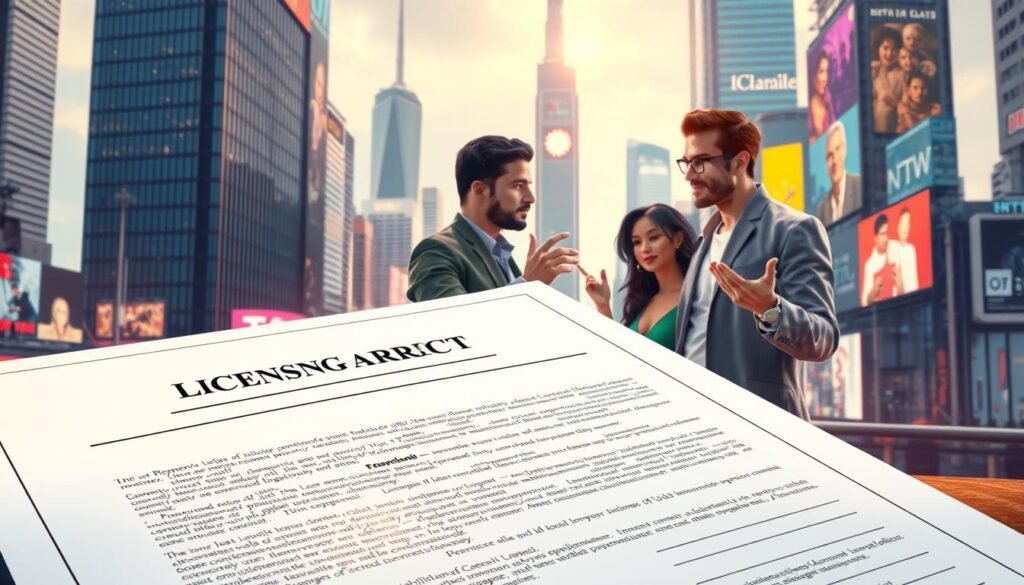Sell AI Art Online in 2025
The world of digital art is changing fast, and AI-generated art is leading this change. As we enter 2025, artists have more chances than ever to make money online.
Digital marketplaces are growing, and people want unique digital content. This makes selling AI art online a great way to earn money. Knowing where to sell your art is key, from online stores to your own website and licensing deals.
Using smart strategies, artists can earn more and have a lasting career in digital art.
Key Takeaways
- Discover the most profitable channels for selling AI-generated art online.
- Learn effective pricing strategies for your digital art.
- Understand the benefits of creating digital download bundles.
- Explore the licensing your AI art.
- Maximize your earnings through diversified sales channels.
Understanding the AI Art Market in 2025
The AI art scene is changing a lot in 2025. This is because of new tech and what people want to buy. For artists to do well, they need to know what’s popular and what buyers like.
Key Trends to Watch
There are a few big trends in AI art. AI-generated art is getting better, making very realistic and detailed pieces. Also, AI is being used with traditional art, making new kinds of art that many people like.
AI is also making new kinds of art, like generative art. This is art made by an algorithm based on certain rules. This trend is likely to keep growing in 2025.
Popular Styles and Techniques
In 2025, some popular AI art styles are abstract art made with neural networks and surrealist art made with GANs. These styles are eye-catching and show how AI can be used in art.
Style transfer, where one image’s style is put on another, is also getting popular. This lets artists try out different styles and make unique art.
Consumer Preferences and Demographics
To succeed in AI art, you need to know what buyers want. In 2025, people want art that looks good and tells a story. They also want to know the story behind the art, like how it was made and the tech used.
The buyers of AI art are mostly young people, like millennials and Gen Z. They are okay with digital art and the tech that goes with it.
Setting Up Your Online Store
Creating a professional online store is key for AI artists to reach more people and sell more art. A good online store showcases your art well and makes buying easy for customers.
Choosing the Right Platform
Picking the right e-commerce platform is vital for your store’s success. Shopify, WooCommerce, and Big Cartel are popular choices, each with its own strengths.
- Shopify: Known for its user-friendly interface and extensive customization options.
- WooCommerce: A flexible platform ideal for those already familiar with WordPress.
- Big Cartel: Offers a straightforward, easy-to-use interface perfect for artists with smaller inventories.
When choosing a platform, think about transaction fees, payment gateway integration, and scalability as your business grows.
Essential Features of an Online Art Store
An effective online art store should have several key features. These features improve the customer experience and boost sales.
| Feature | Description | Benefit |
|---|---|---|
| High-Quality Image Display | Showcases art in high resolution | Enhances customer viewing experience |
| Detailed Art Descriptions | Includes information about the art piece, such as inspiration and creation process | Provides context, increasing art’s perceived value |
| Secure Payment Processing | Offers multiple payment options and ensures transaction security | Builds customer trust, reducing cart abandonment |
Pricing Strategies for AI Art
Pricing AI art correctly is vital for attracting buyers and ensuring profitability. Consider the following strategies:
- Cost-Based Pricing: Calculate the cost of creating the art and add a markup.
- Value-Based Pricing: Price based on the art’s perceived value to the customer.
- Competitive Pricing: Research what similar AI art pieces are selling for and price competitively.
By understanding your costs, the value your art provides, and the competitive landscape, you can set prices that are both competitive and profitable.
Leveraging Social Media for Sales
In 2025, using social media is essential for boosting AI art sales. Social media platforms are vital for artists to share their work worldwide.
Best Platforms for AI Art Promotion
Each social media platform is best for different types of content. For AI art, Instagram and Pinterest stand out because they focus on visuals.
- Instagram: Use Instagram’s Stories, Reels, and IGTV to show off your art in different ways.
- Pinterest: Make boards for your AI art categories to help buyers find your work.
Creating Engaging Content
To grab the attention of buyers, your content must be engaging. This includes:
- Telling the story behind your art.
- Showing how AI algorithms help create your art.
- Talking with your followers through comments and messages.
Building a Community Around Your Art
Creating a community around your AI art can lead to loyal fans. To do this, try:
| Strategy | Description | Benefit |
|---|---|---|
| Regular Posts | Post consistently to keep your audience interested. | Keeps your audience engaged. |
| Collaborations | Work with other artists or influencers. | Expands your reach. |
| Contests and Giveaways | Host contests or giveaways for your followers. | Encourages engagement. |
By using social media well, you can increase your AI art sales. You’ll also build a dedicated community of art lovers.
Utilizing Marketplaces to Expand Reach
Online marketplaces are a great way for AI artists to show and sell their work. They can reach more people and find more customers.
Top Online Marketplaces for AI Art
Some online marketplaces are perfect for AI art. Etsy is great for selling AI art prints. NFT marketplaces like OpenSea and Rarible are also good for unique digital art.
These sites have people who love digital and AI art. This makes it easier for artists to get noticed and sell their work.
Tips for Listing Your Art
Here are some tips for listing your AI art:
- Use high-quality images of your art.
- Write detailed descriptions, including the inspiration behind the piece and the techniques used.
- Optimize your listings with relevant keywords to improve search visibility.
- Engage with buyers by responding to comments and messages quickly.
Understanding Marketplace Fees
It’s important to know the fees of the marketplaces you use. For example, Etsy charges listing, transaction, and payment processing fees. NFT marketplaces might charge gas fees for minting NFTs and a commission on sales.
By knowing these fees, AI artists can price their work right. This helps them stay profitable. Reviewing each marketplace’s fees helps artists choose where to sell their art wisely.
Building a Personal Brand
The AI art world is growing fast. Creating a unique personal brand is more important than ever. With so many talented artists out there, a strong brand helps you shine and connect with your audience better.
Creating a Unique Artistic Identity
Building a unique artistic identity is the base of your personal brand. It’s not just about your style and skills. It also includes your values, what inspires you, and the story behind your art. Consistency is key; make sure your brand looks the same everywhere, from your website to social media.
Crafting a compelling narrative around your art can make your identity stronger. Talk about your creative process, the challenges you face, and how you solve them. This makes your brand more relatable and builds an emotional bond with your audience.
Importance of Branding in Art Sales
Branding is key in selling art. A strong brand can lead to higher prices and more buyers. It’s not just about the art; it’s about the experience and story behind it. A strong brand can attract loyal fans who want to buy your work and support your art.
Also, a clear brand identity helps in marketing your art. It gives you a unique selling point (USP) that sets you apart from others. This is vital in the AI art market, where technology makes creating art easier but also more competitive.
Strategies for Brand Promotion
Promoting your brand needs a mix of strategies. Using social media is a great way to reach more people. Share your art, talk to your followers, and use hashtags to get seen more. Working with other artists or influencers can also help you grow your audience.
Email marketing is another powerful tool. Building an email list lets you send updates directly to your fans. Share new art, announce events, or sales. It’s a personal way to keep your followers interested and informed.
- Develop a consistent visual brand identity.
- Engage actively on social media platforms.
- Utilize email marketing to connect with your audience.
- Collaborate with other artists or influencers.
Engaging with Your Audience
To build a loyal community around your AI art, you need to engage with your audience regularly. This connection helps you create a strong bond with your fans. It also makes them more likely to come back and buy from you again.
Utilizing Email Marketing
Email marketing is a powerful tool for connecting with your audience. By creating an email list, you can send updates directly to your subscribers. Share news about new art, special deals, or upcoming events.
To make your emails more effective, tailor them to each person’s interests. This approach can boost your open rates and lead to more sales.

Running Contests and Giveaways
Contests and giveaways are great for creating excitement around your AI art. They encourage people to get involved and share your work. This can help you grow your social media following and attract new fans.
When you host a contest, make sure the rules are clear. Ask people to share your post, tag their friends, or even submit their own AI art. This not only spreads the word but also builds a sense of community.
Hosting Virtual Events or Webinars
Virtual events and webinars are a fantastic way to interact with your audience live. You can show off your art-making skills or teach about AI art techniques. You can even talk about the art market.
To host a successful virtual event, pick a platform that’s easy for everyone to use. Advertise your event on social media and through email to get more people to join.
| Engagement Strategy | Description | Benefits |
|---|---|---|
| Email Marketing | Direct communication with your audience through personalized emails. | Improved open rates, increased conversions, and enhanced customer loyalty. |
| Contests and Giveaways | Events that encourage audience participation and engagement. | Increased social media engagement, broader reach, and a sense of community. |
| Virtual Events/Webinars | Live interactions with your audience through demonstrations or educational content. | Real-time engagement, educational opportunities, and increased brand visibility. |
Optimizing Your Sales Funnel
A well-optimized sales funnel can greatly increase your AI art sales. It guides customers smoothly through the buying process. Knowing the customer journey and using effective strategies are key to boosting conversions.
Understanding the Customer Journey
The customer journey includes all interactions with your brand, from first awareness to purchase. Mapping out this journey reveals areas for improvement and customer pain points.
Consider these stages in the customer journey:
- Awareness: How do customers first hear about your AI art?
- Consideration: What factors influence their decision to purchase?
- Purchase: How can you make the buying process smoother?
- Retention: How can you keep customers coming back for more?
Effective Call-to-Actions
Call-to-actions (CTAs) are key in your sales funnel, encouraging customers to act. Crafting compelling CTAs means using action words and creating urgency.
| CTA Type | Example | Purpose |
|---|---|---|
| Direct | “Buy Now” | Encourages immediate purchase |
| Soft | “Learn More” | Educates the customer before a purchase |
| Promotional | “Get 10% Off” | Creates a sense of urgency with discounts |
Techniques for Reducing Cart Abandonment
Cart abandonment is a big challenge in e-commerce. Implementing strategies to reduce cart abandonment can boost conversion rates and sales.
Some effective techniques include:
- Simplifying the checkout process
- Offering multiple payment options
- Sending reminder emails for abandoned carts
Collaborating with Other Artists
Working with other artists can grow your audience and open new sales paths. In the AI art world, it’s more than just teamwork. It’s about making something new and exciting that more people will like.
Benefits of Collaboration
Collaborating with other artists brings many advantages, including:
- Increased Exposure: Artists can reach more people by teaming up. This way, they can find new customers they might not have found alone.
- Creative Synergy: Working together can lead to art that’s unique and innovative. This might not be possible for one artist alone.
- Shared Resources: Artists can split costs by sharing things like marketing, studio space, or equipment. This makes things more efficient and saves money.
How to Find the Right Partner
Finding the right partner is key for a good collaboration. Here are some tips:
- Identify Common Goals: Look for artists who have the same vision and goals as you.
- Assess Their Style: Make sure their style fits well with yours.
- Evaluate Their Audience: Check if their audience is similar to yours. This helps ensure your art will appeal to the same people.
Successful Collaboration Examples
Many successful collaborations have happened in the AI art world. For example, artists have teamed up to create big AI art installations. These have been shown in galleries and exhibitions.
These collaborations not only make amazing art. They also get a lot of media attention. This helps the artists become more well-known.
By working with other artists, you can find new chances, grow your audience, and make art that really stands out.
Exploring Licensing Opportunities
With AI-generated art on the rise, knowing about licensing is key. Licensing your AI art to businesses can be very profitable. It lets artists earn money from their work in ways beyond just selling it.
Types of Licensing for AI Art
AI artists have several licensing options. These include:
- Exclusive Licensing: Giving one company the right to use your art.
- Non-Exclusive Licensing: Letting many companies use your art at the same time.
- Print Licensing: Allowing companies to print your art on different products.
- Digital Licensing: Licensing your art for digital use, like in ads or on websites.
Knowing these options helps you plan your licensing strategy better.
Approaching Businesses for Licensing Deals
To license your AI art, you must approach businesses well. This means:
- Finding companies that match your art style and values.
- Creating a professional portfolio to show off your art.
- Reaching out with a clear proposal that shows why your art is good for them.
Building a strong network and keeping good relationships with clients can help you get more deals.

Crafting Licensing Agreements
Creating a solid licensing agreement is essential. It protects you and makes sure the partnership works well. Important parts to include are:
- The scope of the license, like exclusivity and where it can be used.
- Royalty rates and how you’ll get paid.
- How long the license lasts.
- Any rules on how the art can be used.
It’s smart to get a lawyer’s help to make sure your agreement is strong and protects your rights.
Monetizing Through NFTs
NFTs are changing how artists sell digital art, opening new ways to make money. The rise of NFTs for selling digital art has given AI artists new chances to earn from their work.
Getting Started with NFT Sales
To sell AI art as NFTs, artists must learn the basics of NFTs. This means setting up a digital wallet, picking an NFT marketplace, and learning how to mint NFTs.
- Create a digital wallet: Artists need a cryptocurrency wallet to store and manage their NFTs.
- Choose an NFT marketplace: Popular platforms include OpenSea, Rarible, and SuperRare.
- Mint your NFTs: This involves creating a unique digital asset on a blockchain.
Platforms for Selling AI Art as NFTs
Many NFT marketplaces are available for digital art, each with its own features and fees. Here’s a look at some popular ones:
| Platform | Fees | Features |
|---|---|---|
| OpenSea | 2.5% on sales | Large user base, easy minting process |
| Rarible | Variable fees | Decentralized governance, customizable storefronts |
| SuperRare | 15% on primary sales, 10% on secondary | Curated art, high-quality thumbnails |
Legal Considerations for NFT Creation
When making and selling NFTs, artists need to know the legal side. This includes copyright laws, smart contract rules, and taxes.
Key Legal Considerations:
- Copyright and ownership: Make sure you own the rights to the art you’re minting as an NFT.
- Smart contract laws: Know if smart contracts are legally binding in your area.
- Tax implications: NFT sales might be taxed, so understand the tax rules.
By knowing these legal points, AI artists can make money from their art through NFTs. They can tap into the growing demand for unique digital items.
Incorporating Print-On-Demand Services
Print-on-demand services have changed the game for AI artists. They can now focus on creating without worrying about production and shipping. This makes it easier for artists to make money from their work.
Models for Success
Print-on-demand is a flexible and affordable way to sell AI art. Artists can sell their designs on prints, clothes, and home decor. They don’t need to keep any stock because the service handles it all.
Key benefits of using print-on-demand services include:
- No upfront costs or inventory risks
- Ability to offer a wide range of products featuring AI art
- Scalability to meet demand without logistical hassles
Top Services for AI Art Printing
Many services help artists print their AI art. Here are some of the best:
- Society6: Known for its wide range of products and global reach
- Redbubble: Offers a diverse array of products and a strong community of artists
- Teespring: Specializes in custom apparel and accessories
Effective Marketing Strategies
To market AI art prints well, artists should use social media, email, and team up with influencers. Sharing the story behind the art can also draw in buyers.
Marketing tips include:
- Utilizing Instagram and Pinterest to showcase AI art in lifestyle settings
- Building an email list to promote new art and exclusive offers
- Partnering with influencers to expand the reach of AI-generated art
Staying Updated with Technology
The world of AI art is changing fast. New tools and methods pop up all the time. To keep up, it’s key to know the latest in AI art creation.
Emerging Technologies
New advancements in AI art include better machine learning and augmented reality. These changes will keep shaping the art scene. They open up new ways for artists to share their work.
Streamlining Your Workflow
Using the right AI tools can make your art-making process better. Tools like Deep Dream Generator and Prisma are getting more popular. They let artists try out new styles and methods.
The Importance of Ongoing Education
Learning never stops in AI art. Keeping up with new trends and tech is essential. This way, artists can stay ahead and succeed in their field.


